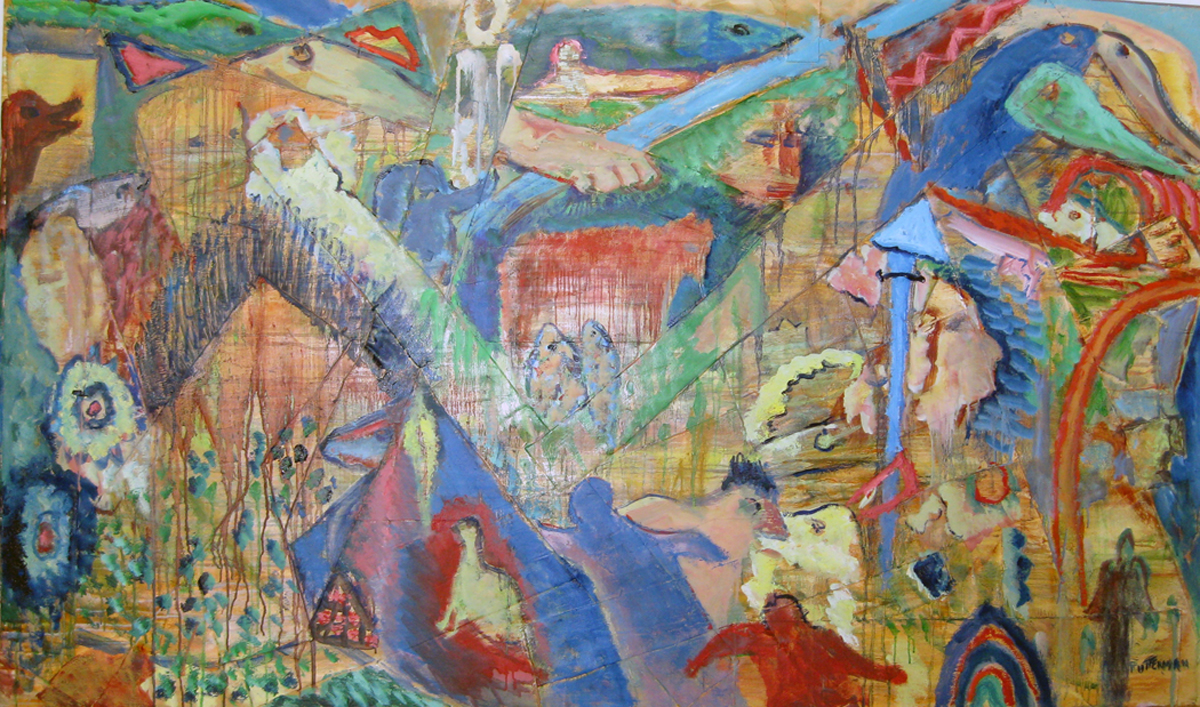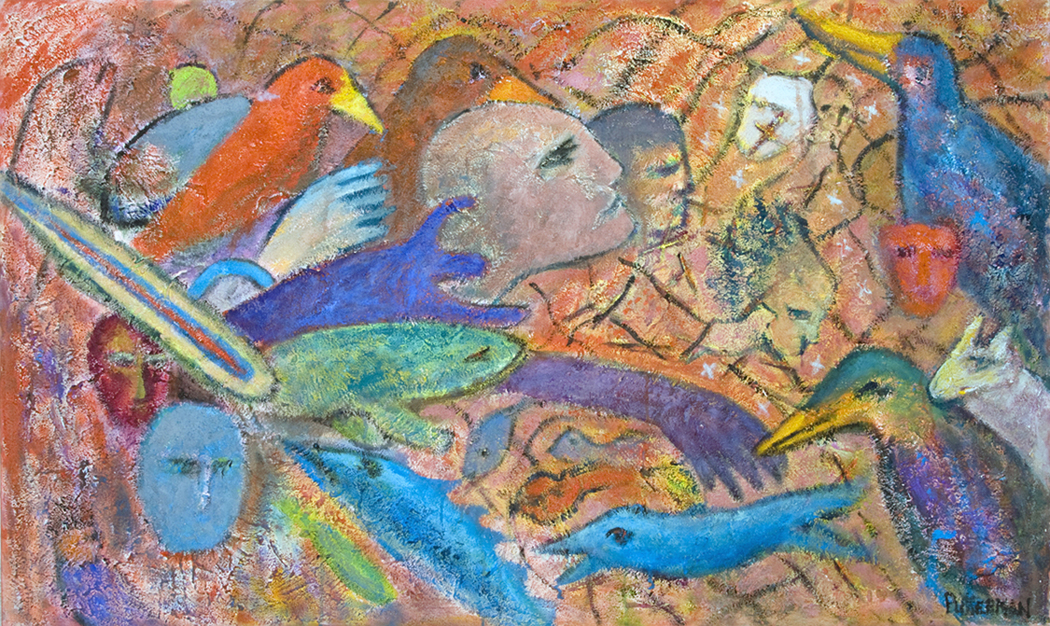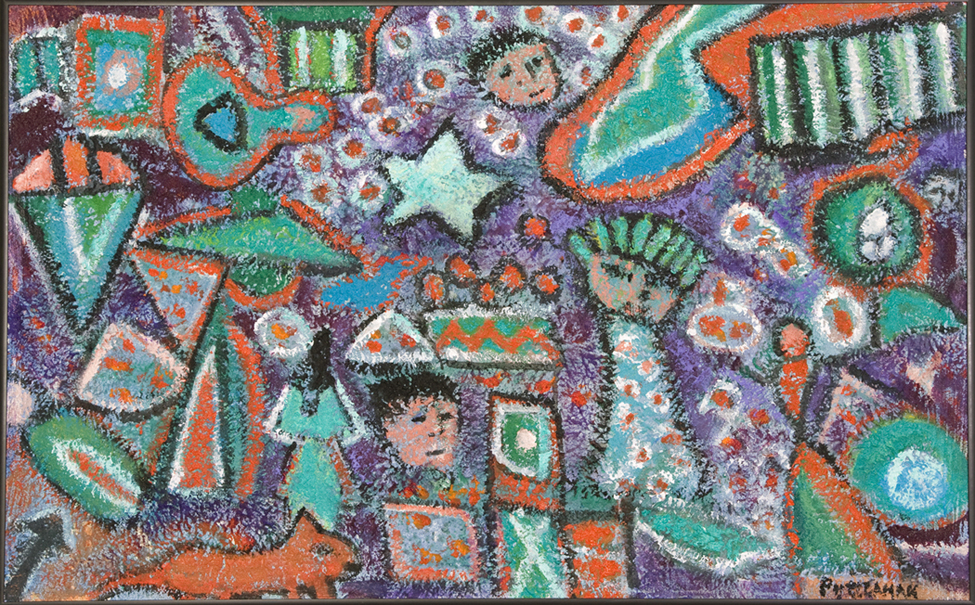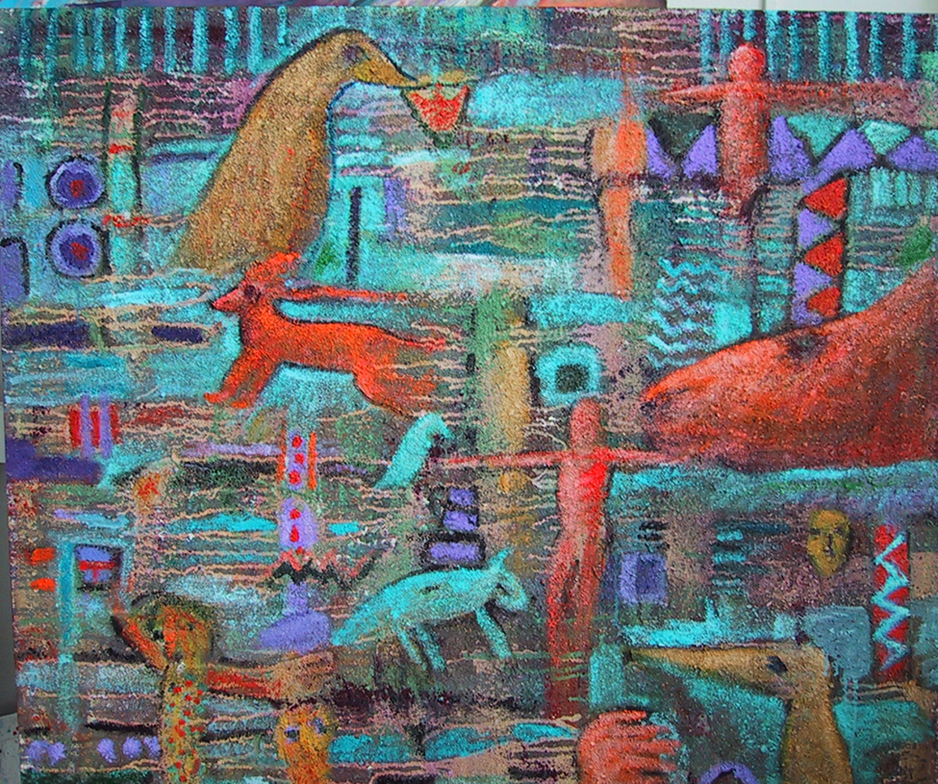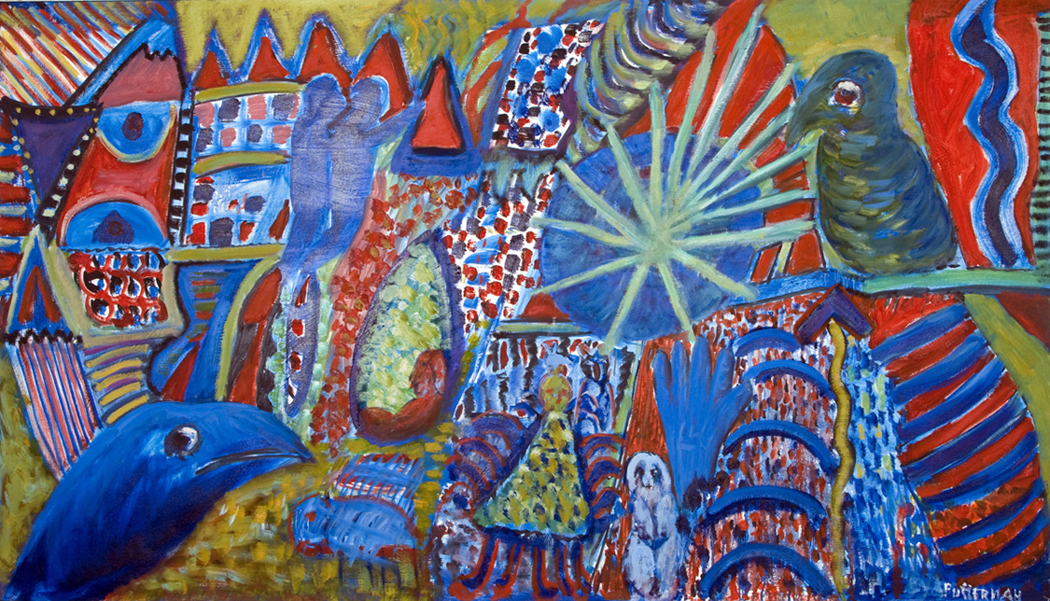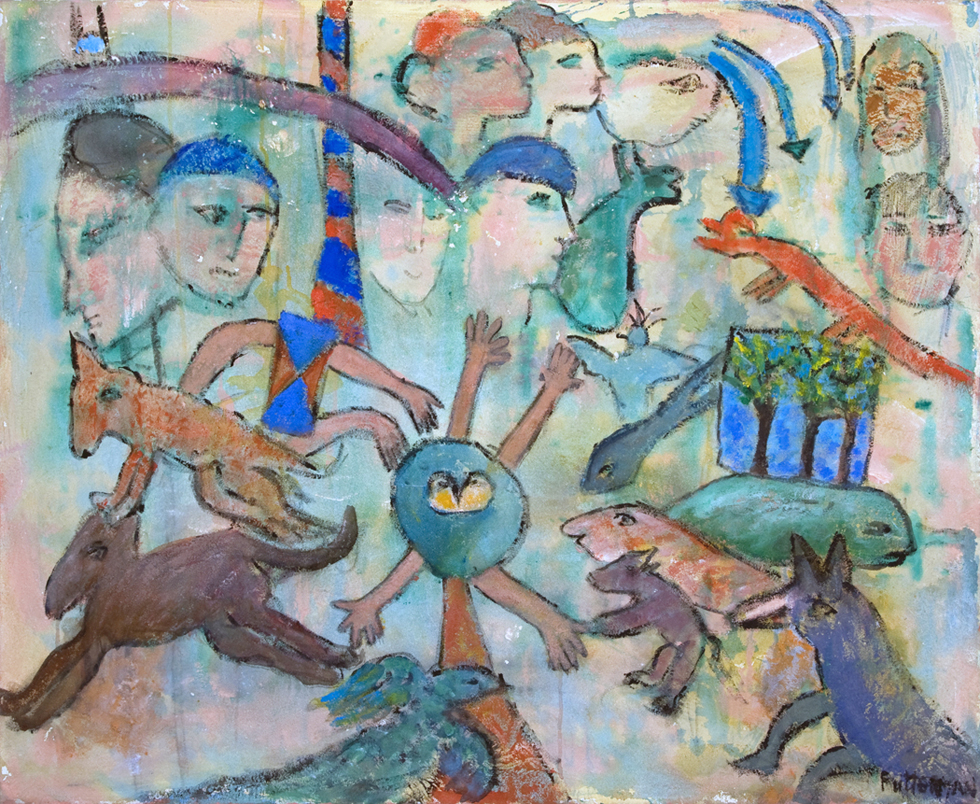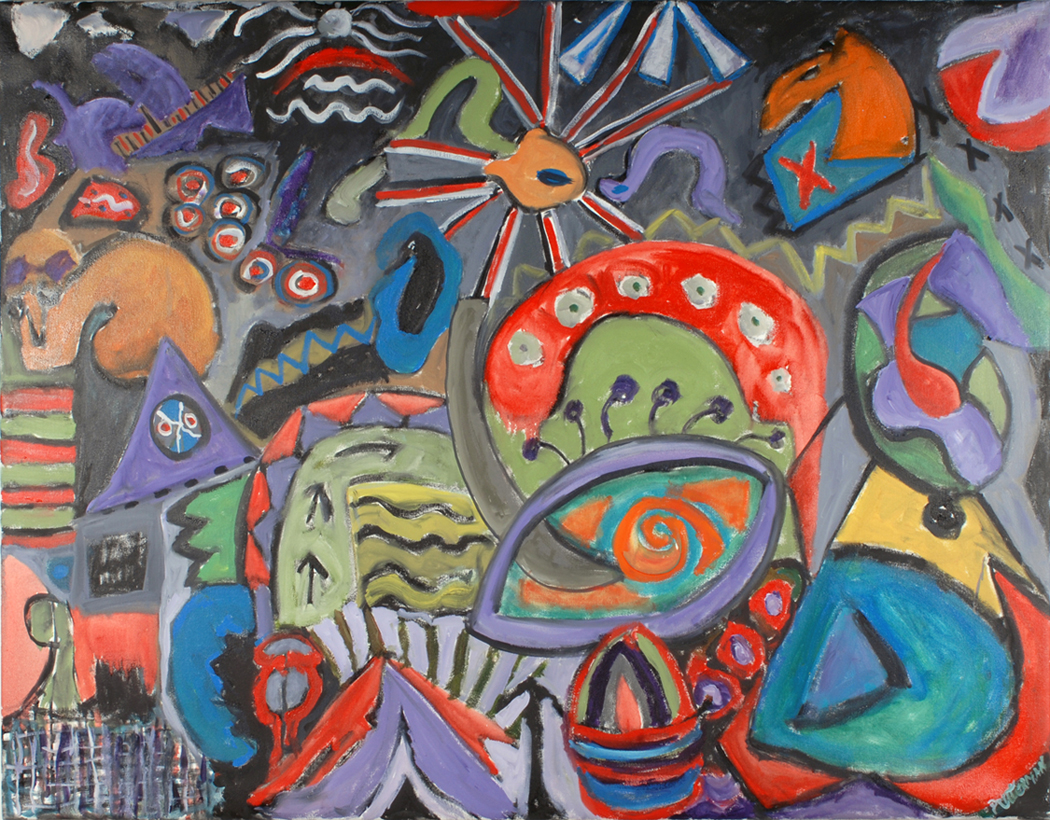Villanova, PA — Overcoming a mid-life start as a career artist, Florence
Putterman has forged international recognition as a post modern
painter/printmaker noted for the narration that she injects into her
quasi-abstract and surreal depictions of animals, sea creatures, birds and
humans coexisting in a delightfully riotous, sometimes edgy harmony.
“Putterman has delved into time itself for her personal symbolism, digging
deep, descending into the mouths of Paleolithic caves to recover something
of the awe, fear and wonder that galvanized the prelapsarian mind. In so
doing, she creates her own wholly modern, imperishable visions – touched
with foreboding, but filled with love and hope,” art historian, curator,
critic and novelist David Cleveland wrote of a Putterman exhibit.
A solo exhibit of paintings, prints, sculptures and collages by the
indomitable 84-year-old artist launches Villanova University Art Gallery's
2011-2012 season. Putterman's show, “Entwined Metaphors”, opens Monday, August 22. A free public reception to meet the artist will take place on Friday, September 9, from 5 to 7 pm in the Art Gallery located in the
Connelly Center on the Villanova campus. Refreshments will be served.
On-campus parking is convenient and free.
Gender convention and marital expectations of parents for their daughters prevalent in the 1940s were significantly responsible for Brooklyn-born Florence Hirsch's late arrival to a full-blown art career. While she
fervently wanted to study art, her parents wanted her to pursue a college
curriculum more likely to lead to marriage. They acceded to her second
choice of advertising and journalism at New York University, though she had
no particular interest in either. They would, however, help her out decades
later when she set out to promote her long deferred career as an artist.
She married businessman Saul Putterman before graduating NYU, moved a few years later to Selinsgrove, PA, where her husband's work took them, managed their home, raised two sons, and found something missing. Her involvement in a local women's group kindled a determination to become the artist she once believed she was destined to be.
She studied painting at Bucknell University, later adding etching,
silkscreen, woodcuts, lithography, ceramics, photography, collage and
sculpture to her portfolio of skills. She showed her work in local exhibits, and liked the feeling of winning prizes and blue ribbons. “I knew that I would not be satisfied until my work was shown and appreciated by
others,” she says.
Apart from striving for artistic recognition, she became active in the
regional art scene. She served as a public school artist-in-residence,
taught art at the college level, mentored students, and helped launch a
community art school offering low-cost classes to adults and children in
painting, pottery-making, puppetry, printmaking and other mediums. Years
later, after making her mark as an artist, she established the Florence
Putterman Foundation through which she would donate her work to hospitals,
schools and other not-for-profit organizations.
While her still lifes, and especially landscape paintings, were gaining
positive critical attention (Putterman has“a reverence for landscapes,” one
reviewer wrote.), she was advised she needed to branch out and “do something with more meaning.”
On a Valentine's Day, after casting about for a new motif, she began
creating stylized images of the heart as a timeless and universal symbol,
and lithography as her medium of choice. As Europe was then more of a
center for print art than the United States, she began building working
collaborations with master printers in France and Italy. While admired by
some important reviewers, her heart prints did not generate the widespread
interest she had hoped.
Still intent on advancing her education, she enrolled in Penn State's Master of Fine Arts program. Although feeling out of time and place alongside classmates not long out of high school, she stayed on to get her MFA. “I felt old and straight,” she says. With her degree in hand, her children married, and her husband as busy as ever, she settled in at home, bought an etching and lithography press and wondered “What now?” Then serendipity took a hand.
One day, “while fooling around with my etchings”, she began experimenting with monotypes, the medium upon which she would center her reputation as an artist for many years. A relatively minor art form in the United States when Putterman began producing them in the early 1970s, the unreproducible monotype has since become increasingly popular.
From travels to Greece, she produced an Aegean Series of lithographs; a trip to Israel inspired her Western Wall Series on paper. She returned to her
hearts, manipulating their shapes and symbols, and issued the results as
Heart Parts and Heart Fragments to much more responsive audiences intrigued by their greater possibility of meanings. It was a trip to New Mexico and its prehistoric rock engravings, or petroglyphs, that brought Putterman a
National Endowment for the Arts grant and the beginning of the artistic
breakout she had long sought.
Viewers of her petroglyph paintings and prints were especially taken when she began to render abstract and symbolic images of humans, nature, birds, and animals on giant canvasses and four-foot wide paper surfaces primed with a mixture of sand and sea shells. Inspiration for the highly textured and irregular surfaces came one day while Putterman was gazing out at the beach from her winter home in Sarasota, FL.
At first somewhat literal, Putterman's petroglyph-inspired paintings and
prints, their rough, uneven surfaces hearkening to the rock surfaces into
which they were carved eons ago, became more complex, and colorful. “. . .
the pictographic animals have been fleshed out to colorful, folkish fauna
occupying multi-hued worlds of patterns and stylized flora,” wrote Florida
reviewer Kevin Dean. He also noted the artist's “growth in terms of both
the imagery and understanding of the relationship between humans and
nature.”
Another reviewer saw Putterman's work depicting humans and animals
coexisting in a shared natural environment as containing “some of today's
most timely and meaningful imagery.”
Putterman was aware that her work was drawing upon deep regions within herself. As she has allowed her subconscious to be her guide, the more her art has resonated with viewers. “What I'm creating, she says “is work for
people to enjoy and find their own stories in. I'm really not trying to
achieve anything but have the viewer make his or her own interpretation.”
Despite her late start as an artist, Putterman has had more than 100 solo
art exhibits. Her work is included in more than 75 museum, corporate and
university collections, not to mention the numerous hospital and other
not-for-profit spaces that hold the works gifted through her foundation.
At 84, Putterman looks into the future. She plans, she says, “to paint
until I drop.”
The Villanova University Art Gallery is open weekdays from 9 am into most evenings. For extended and weekend hours, and other information, telephone the Art Gallery at (610) 519-4612. Selected works for the Putterman exhibit may be previewed on the gallery’s website at www.artgallery.villanova.edu. The exhibit continues to October 5.
Florence Putterman
(August 22 - October 5, 2011)
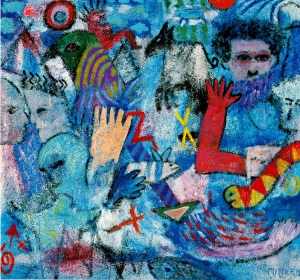
Dreams Voices Illusions, Acrylic on Canvas 68" x 92"



